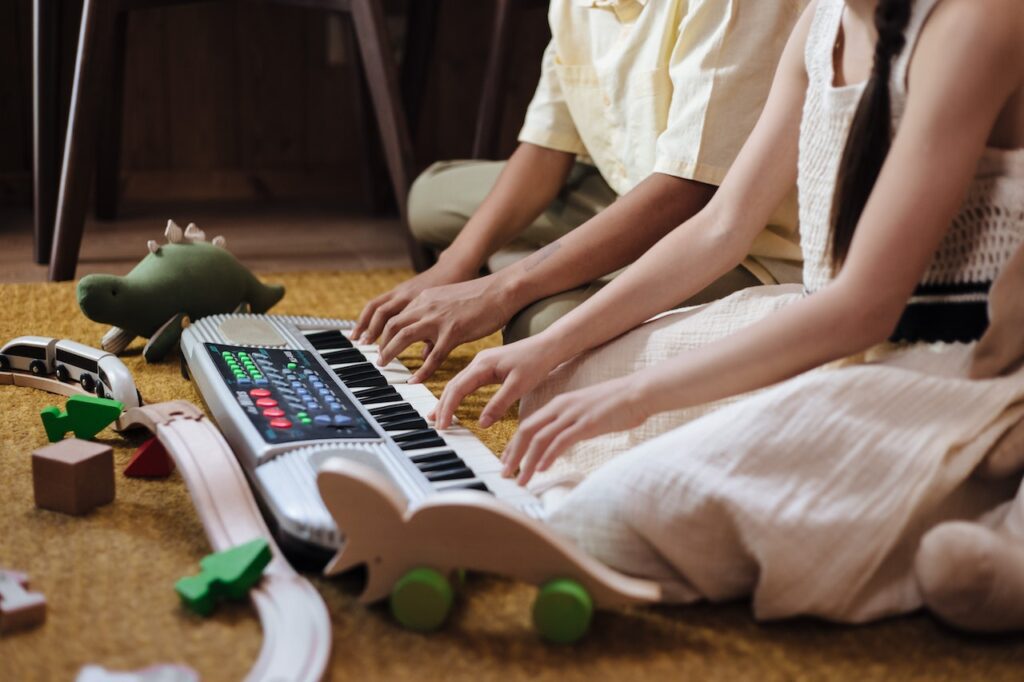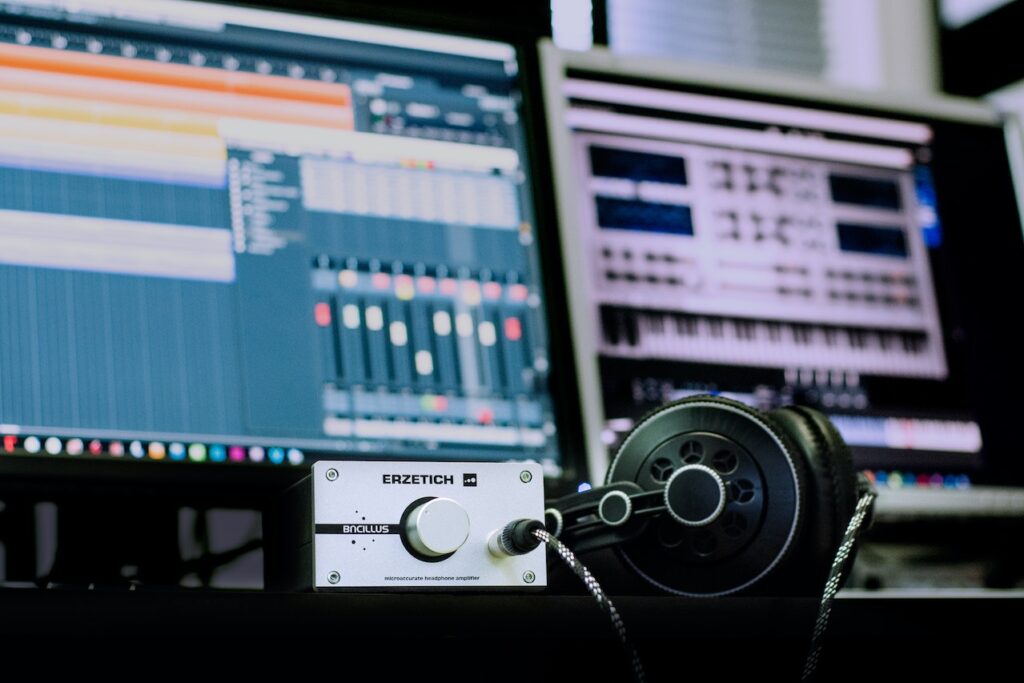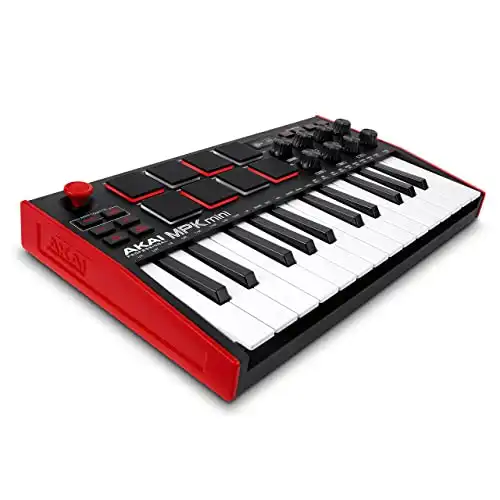Has your child expressed an interest in making electronic music? Do you feel lost as to how to help and encourage them? Or maybe you’re skeptical about the value of learning to start making electronic music? Help is at hand!
In this post, we’ll look at why electronic music production is a great way for kids to get involved in music-making. We’ll also explore what steps you can take to help your child get started, and what they’ll need to begin.
What is electronic music?
The term “electronic music” refers to music made using electronic, digital, or circuitry-based instruments. It covers everything from the strange sounds of the early electroacoustic tape music pioneers to the perfectly polished EDM (electronic dance music) of today, and a whole lot in between. We can make electronic music using analog equipment, such as synthesizers, or digital equipment, such as computers.
Most modern music has at least some element of electronic music, regardless of the instruments used. Recording and production are usually done with computers, and DAWs (digital audio workstations) have come so far that in many cases they have replaced traditional recording studios. In this post, we’ll focus on digital production as it is by far the most popular way to make electronic music today.
Why go electronic?
Although it’s not been around for such a long time, electronic music has a rich history. The days of it being looked down upon as an art form are long gone! There are several reasons why taking an electronic path to learn music is a good choice. These include:
- Flexible and affordable: It’s easy to get started with very little equipment. These days, It’s possible to make professional quality music with just a smartphone! It’s also easy to experiment with styles and sounds with minimal cost.
- A great way to learn music theory: Just like playing a ‘traditional’ instrument, making music electronically opens the door to learning about how music and sound work.
- Exciting career opportunities: The skills involved in producing electronic music are in high demand, and are transferable across many industries.

Where do we begin?
It’s easier than ever for kids to start making electronic music. It doesn’t matter if they have no musical experience, and it doesn’t have to be expensive or complicated to get started. Kids often hear music and say “I want to do that too!” It’s our job as parents or caregivers to make that possible, without piling on too much pressure. It’s important to remember that children’s interests can change quickly, and that’s OK.
- Find out what they’re interested in: The first thing to do is work out what aspects of electronic music your child is excited about, and what kind of sounds they want to create. This will affect what equipment and software you’ll need. Don’t worry about this too much though – pretty much all the options available allow for a huge variety of creative interests and approaches.
- Start simple: There are plenty of ways for kids to get a taste of producing electronic music without investing a lot of money in software or equipment. Start with simple hardware and software that allows them to experiment and build their knowledge and confidence without being overwhelming. Check out this video from Mix Major music school for some tips.
- Consider lessons: Once you know your child is serious about making electronic music, it could be a good idea to get them lessons. Music schools often have courses in electronic music production, and there are many options online. YouTube is also a great resource – there are plenty of tutorials to dig into that will show your child the basics and more.
What equipment do we need?
One of the most exciting things about making electronic music is that it’s easy to get started. You might already have all the equipment your child needs to begin making electronic music straight away!
Essential equipment
- Computer, tablet, or smartphone: Unless your child wants to jump into using 1970s synthesizers or try their hand at circuit bending, they’ll need a computer, tablet, or smartphone. The hardware must be powerful enough to run your chosen software, but it doesn’t need to be state-of-the-art.
- Software: Whatever hardware your child uses, there is software to suit. Music production software for smartphones and tablets is less powerful than software for larger computers, but it’s a good place to start for young kids. Older kids might be happier with a more advanced DAW.
- Headphones: Although it’s possible to use the built-in speakers of whatever hardware you’re using, a good pair of headphones is better. Headphones let the musician hear what they’re doing and also aid immersion – making it easier to concentrate without getting distracted.
Optional equipment
- Keyboard: A keyboard is the perfect companion for any child’s musical journey. It makes experimenting with sounds and melodies simple. Also, keyboard skills come in handy in all areas of music.
- MIDI controller: As kids get more adept, a MIDI (Musical Instrument Digital Interface) controller is a fun addition. There are many different types available, and they are an exciting way to experiment with sound.
- Microphone: If your child wants to record vocals, a good microphone is helpful. The in-built microphones that come with computers, phones, and tablets aren’t ideal as the quality tends to be quite poor.
For a little bit extra you can get some equipment that gives your child more tactile engagement when making music. Our go to for this is the MPK Mini
Our absolute favorite way to get started with making electronic music! The MPK mini is a classic and has a little bit of everything you need to get going with making music with the DAW of your choice.
What is the best music production software for kids to use?
There are a lot of software options out there, and the one you choose will depend on your hardware. It’s best to start with something simple, especially for young kids. Some DAWs are pretty complicated and could become overwhelming for kids.
Software for smartphones and tablets
One of the most popular DAWs for children is Apple’s free app GarageBand. It’s easy to use and has plenty of features to explore. If you have an iPhone or an iPad, GarageBand is probably the best place to start.
There are hundreds of audio editing apps for Android, with both free and paid options available. Some apps are more complex than others, and the best choice will depend on the age of your child. The free app BandLab would be a good choice for most as it’s simple to use and has a good set of features for beginners.
Software for computers
There are a huge number of DAWs available for Windows, Mac, and Linux systems. These are generally more complex than the apps for smartphones and tablets, and the learning curve can be steep. They can also be expensive! The right choice for your child will depend on their age and their willingness to learn how to use the software.
It’s best to start with something simple and let your child lead the way – they’ll let you know when they want to move on to something more advanced. Once again, if you have a macOS, GarageBand is probably the best choice for kids. For older kids, Ableton Live Lite (Windows, macOS) is a good option as it has plenty of features but is simpler than the full Ableton Live. It’s also free! There is also the professional version of GarageBand: Logic Pro
FL Studio (Windows, macOS) is another good choice for older kids who are happy to spend some time getting to grips with the software. It’s fun to use and feature-rich, with a free trial version that has all the features of the paid version and has no time limit.
Options for Linux systems are more limited, but open source programs like Ardour and LMMS (both also available for Windows and macOS) have all the features you would expect and are free. Working with audio on Linux can be a challenge because of compatibility issues, so it’s probably not the best choice for young kids.
In conclusion

Getting into creating electronic music has never been easier, and there are options to suit children of all ages. It’s also an affordable way to get into music, with hardware and software available for every budget.
When kids learn how to produce electronic music, they get the opportunity to experiment with a wide range of sounds and musical styles. The skills they pick up are transferable across the world of music and beyond, and are in high demand. So, if your child wants to get into making electronic music, get ready to help them as much as you can!
Written by: Liz Sullivan
